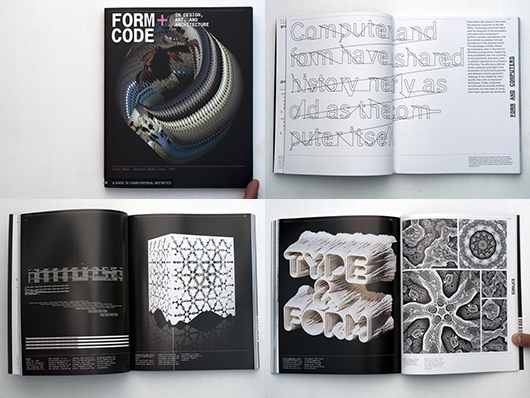Via Vague Terrain
-----

In creating a foundational piece of software infrastructure Ben Fry and Casey Reas have done myself and countless peers a great service and helped launch thousands of arty new-media applets. In Form+Code (F+C) Reas teams up with Chandler McWilliams and LUST design studio to produce a slim introductory text on procedural and code-influenced art and design. While the book makes only the briefest mention of Processing, a good percentage of the work documented in it can be traced directly or indirectly to the platform that emerged from the MIT Aesthetics and Computation work group. F+C also includes historical precedents, from loving documentation of green Cathode Ray Tube Spacewar!, to one of Sol LeWitt's wall drawing instruction cards (presented here as code only — LeWitt's typed out gallery proposal). There are a few other nods to post-minimalism and other pre-P5 projects. Additionally, F+C also breaks out of the screen-based ghetto, including images from proposed and built architectural investigations, art installations, design prototypes and sculptures.
The book itself is broken down into conceptual chapters that explore techniques that are code-like or only practically achievable with code-based tools: repetition, geometric transformation, parametrization, visualization, simulation. Each chapter includes spare descriptive pages which introduce overall themes and very briefly discuss the documented projects. F+C is a fairly no-nonesense machine -- it moves briskly through its functional structure of chapters, never pausing to dwell on any one project or image. Yoshi Sodeoka's 2004 video work based on presidential State of the Union addresses is presented in much the same way that Marius Watz's beautiful software generated abstractions are. Both sit alongside a Rafael Lozano-Hemmer installation, an elegant Cory Arcangle data-vis deconstruction, images of a Morphosis tower project for Paris, news-stream visualizations, and Mark Lombardi inspired diagramming. To some extent all these projects (and many others) are being stripped mined for the illustration of a technique or concept. This undifferentiated treatment of a really diverse set of work and ideas is, for me, the primary weakness of the book.
Even with some notable omissions in the projects covered, there's likely to be a items here most of us haven't seen yet – I discovered many. If you are looking for an overview and introduction, or a catalog of interesting work, Form+Code will be a useful resource. Ultimately, though, it leaves me hungry for a more focused and critical approach to this incredibly interesting subject. It's clear that Reas, McWilliams and LUST would be particularly well qualified to produce exactly that sort of text.

